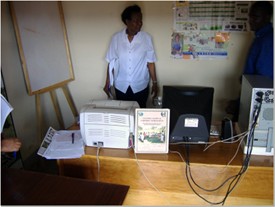
Challenge
Farmers near Kayunga, Uganda, rely on the income generated from sun drying fruit and selling it in bulk to local and European markets. Fruit takes two to three days to dry completely, and even a small amount of rainfall during the drying period can damage a harvest. The absence of basic access to information in developing countries limits the ability of rural populations to receive warnings, forecasts, and observations of hydro-meteorological conditions to improve their livelihoods.
Initiative
In Kampala, Uganda, USAID and the U.S. National Oceanic and Atmospheric Administration (NOAA) have come together to support the development and implementation of a program designed to provide weather and seasonal forecasts to surrounding communities. RANET, which stands for Radio and Internet Technologies for the Communication of Weather and Climate Information for Rural Development, depends on four critical components to move information from capital cities to rural communities: 1) Gathered information being loaded to a satellite via the Internet; 2) Field sites downloading the information using a radio, modem, and PC; 3) Field staff and NGO partners interpreting the information according to the local context and translating it into local languages; and 4) The information being disseminated to communities by word of mouth and FM radio broadcast.
Results
In Kayunga, the Farmers Association is now able to download weather forecasts and disseminate them to the farmers during a field visit by an extension officer. Farmers also use the same RANET system to receive information on other relevant topics such as market prices, crop diseases, health, and general education. In times of delayed on set of rains the weather forecast guides farmers and extension officers to replant crops in the right seasonal rains. This enhances food security. The program has expanded to some 16 African countries and work is being done for pilot programs in Asia and the Pacific.
More detailed information about the initiative can be found at http://www.ranetproject.net/.







Comment
Make a general inquiry or suggest an improvement.